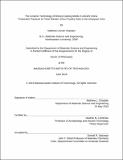| dc.contributor.advisor | Heather N. Lechtman. | en_US |
| dc.contributor.author | Chastain, Matthew Lincoln. | en_US |
| dc.contributor.other | Massachusetts Institute of Technology. Department of Materials Science and Engineering. | en_US |
| dc.date.accessioned | 2019-09-16T16:42:27Z | |
| dc.date.available | 2019-09-16T16:42:27Z | |
| dc.date.copyright | 2019 | en_US |
| dc.date.issued | 2019 | en_US |
| dc.identifier.uri | https://hdl.handle.net/1721.1/122073 | |
| dc.description | This electronic version was submitted by the student author. The certified thesis is available in the Institute Archives and Special Collections. | en_US |
| dc.description | Thesis: Ph. D., Massachusetts Institute of Technology, Department of Materials Science and Engineering, 2019 | en_US |
| dc.description | Cataloged from student-submitted PDF version of thesis. | en_US |
| dc.description | Includes bibliographical references (pages 681-718). | en_US |
| dc.description.abstract | During the second and first millennia BCE, peoples living near China's Yellow and Yangzi Rivers produced bronze ritual and military paraphernalia that represent arguably the most sophisticated use of metal casting by any ancient society. These objects were cast by pouring bronze into mold assemblies composed of interlocking sections. To survive the mechanical and thermal rigors of this casting process, the mold sections were constructed from highly specialized ceramic materials. This study investigates these ceramic materials. The primary focus is three foundry sites (Zhougongmiao, Kongtougou, Lijia) in the Zhouyuan area, Shaanxi province, a major bronze production center during the Western Zhou period (1045-771 BCE). Casting molds (72 total), other ceramic artifacts, and soils, all from the Zhouyuan area, were analyzed using electron microscopy, optical microscopy, and infrared spectroscopy. | en_US |
| dc.description.abstract | Results were compared to similar analyses of molds from other sites in China (Houma, Xinzheng, Tangjiadun, Shigudun). Replication experiments were undertaken to reconstruct the production process of casting molds and to identify the performance advantages of ancient casting-mold material. Casting molds were made from a material unlike the clay-rich pastes used for pottery. This material, here called "silt paste", consists of a porous network of silt-sized (3.9-62.5[mu]m) quartz particles held together by a small proportion of clay. Across north-central China, similar material was used to make molds for all types of bronze objects. Silt paste was produced from commonplace loessic soils. Its composition and properties were manipulated by processing the soil to remove much of its clay. The resulting low-clay paste offers little workability, requiring specialized forming techniques. "Piping" was used to decorate some molds. Molds were fired at 400-700°C. | en_US |
| dc.description.abstract | The low clay content and low firing temperature of casting-mold material ensured minimal drying shrinkage and high thermal shock resistance, minimizing the risk of failure during the casting process. Producers at the three Zhouyuan-area sites practiced different engineering strategies, apparently because casting technology descended from the earlier Shang tradition was introduced into the area midway through the Western Zhou period. Differences in soil resources between northern and southern China may have influenced how bronze casting developed in each region. | en_US |
| dc.description.statementofresponsibility | by Matthew Lincoln Chastain. | en_US |
| dc.format.extent | 718 pages | en_US |
| dc.language.iso | eng | en_US |
| dc.publisher | Massachusetts Institute of Technology | en_US |
| dc.rights | MIT theses are protected by copyright. They may be viewed, downloaded, or printed from this source but further reproduction or distribution in any format is prohibited without written permission. | en_US |
| dc.rights.uri | http://dspace.mit.edu/handle/1721.1/7582 | en_US |
| dc.subject | Materials Science and Engineering. | en_US |
| dc.title | The ceramic technology of bronze-casting molds in ancient China : production practices at three western Zhou foundry sites in the Zhouyuan area | en_US |
| dc.type | Thesis | en_US |
| dc.description.degree | Ph. D. | en_US |
| dc.contributor.department | Massachusetts Institute of Technology. Department of Materials Science and Engineering | en_US |
| dc.identifier.oclc | 1117715028 | en_US |
| dc.description.collection | Ph.D. Massachusetts Institute of Technology, Department of Materials Science and Engineering | en_US |
| dspace.imported | 2019-09-16T16:42:20Z | en_US |
| mit.thesis.degree | Doctoral | en_US |
| mit.thesis.department | MatSci | en_US |
